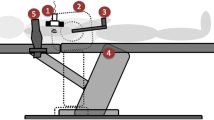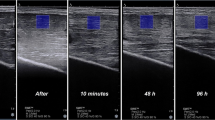Abstract
Purpose
The aim of this investigation was to evaluate the effects of local cryotherapy on the recovery from symptoms of exercise-induced muscle damage (EIMD) on biceps brachii.
Methods
Nineteen untrained women performed an eccentric protocol of damage induction (2 sets of 10 repetitions) in both arms after the baseline data collection. The cryotherapy was applied for 20 min, twice per day, for 4 days following the eccentric exercise. Randomly, one of the subject’s arms was assigned as intervention, and received cryotherapy, the opposite arm served as control. As muscle damage indirect markers, we collected muscle thickness, and echo intensity, delayed onset muscle soreness, and peak torque at baseline (PRE), and at 24, 48, 72, and 96 h.
Results
Muscle thickness at PRE was significantly lower than all time points in both experimental and control arms. Echo intensity at PRE was significantly lower than 24, 48, and 72 h in the experimental arm, and significantly lower than all time points in the control arm. Muscle soreness assessed by flexion–extension, and by self-palpation of both the experimental and the control arms significantly increased compared to the PRE value at 24, 48, and 72 h. Peak Torque of both experimental and control arm was significantly lower than all time points after EIMD. None of the muscle damage indirect markers showed any significant difference between arms at any moment (p > 0.05).
Conclusion
The results demonstrated that the protocol of cryotherapy utilized in the present study was not effective in enhancing the recovery from EIMD in untrained women.




Similar content being viewed by others
References
Bleakley CM, Bieuzen F, Davison GW, Costello JT (2014) Whole-body cryotherapy: empirical evidence and theoretical perspectives. Open Access J Sport Med 5:25–36. doi:10.2147/OAJSM.S41655
Martin SS, Spindler KP, Tarter JW et al (2001) Cryotherapy: an effective modality for decreasing intraarticular temperature after knee arthroscopy. Am J Sports Med 29:288–291
Swenson C, Sward L, Karlsson J (1996) Cryotherapy in sports medicine. Scand J Med Sci Sports 6:193–200. doi:10.1111/j.1600-0838.1996.tb00090.x
Wilcock IM, Cronin JB, Hing WA (2006) Physiological response to water immersion: a method for sport recovery? Sport Med 36:747–765. doi:10.2165/00007256-200636090-00003
Karunakara RG, Lephart SM, Pincivero DM (1999) Changes in forearm blood flow during single and intermittent cold application. J Orthop Sport Phys Ther 29:177–180. doi:10.2519/jospt.1999.29.3.177
Glenn RE, Spindler KP, Warren TA et al (2004) Cryotherapy decreases intraarticular temperature after ACL reconstruction. Clin Orthop Relat Res 2:268–272. doi:10.1097/01.blo.0000126302.41711.eb
Ascensão A, Leite M, Rebelo AN et al (2011) Effects of cold water immersion on the recovery of physical performance and muscle damage following a one-off soccer match. J Sports Sci 29:217–225. doi:10.1080/02640414.2010.526132
Eston R, Peters D (1999) Effects of cold water immersion on the symptoms of exercise-induced muscle damage. J Sports Sci 17:231–238. doi:10.1080/026404199366136
Minett GM, Duffield R, Billaut F et al (2014) Cold-water immersion decreases cerebral oxygenation but improves recovery after intermittent-sprint exercise in the heat. Scand J Med Sci Sport 24:656–666. doi:10.1111/sms.12060
Chen TC, Chen HL, Lin MJ et al (2010) Potent protective effect conferred by four bouts of low-intensity eccentric exercise. Med Sci Sports Exerc 42:1004–1012. doi:10.1249/MSS.0b013e3181c0a818
Flores DF, Gentil P, Brown LE et al (2011) Dissociated time course of recovery between genders after resistance exercise. J Strength Cond Res 25:3039–3044. doi:10.1519/JSC.0b013e318212dea4
Radaelli R, Bottaro M, Wilhelm EN et al (2012) Time course of strength and echo intensity recovery after resistance exercise in women. J Strength Cond Res 26:2577–2584. doi:10.1519/JSC.0b013e31823dae96
Pointon M, Duffield R, Cannon J, Marino FE (2011) Cold application for neuromuscular recovery following intense lower-body exercise. Eur J Appl Physiol 111:2977–2986. doi:10.1007/s00421-011-1924-1
Johar P, Grover V, Topp R, Behm DG (2012) A comparison of topical menthol to ice on pain, evoked tetanic and voluntary force during delayed onset muscle soreness. Int J Sports Phys Ther 7:314–322
Chen TC, Lin KY, Chen HL et al (2011) Comparison in eccentric exercise-induced muscle damage among four limb muscles. Eur J Appl Physiol 111:211–223. doi:10.1007/s00421-010-1648-7
MacIntyre DL, Reid WD, Lyster DM, McKenzie DC (2000) Different effects of strenuous eccentric exercise on the accumulation of neutrophils in muscle in women and men. Eur J Appl Physiol 81:47–53. doi:10.1007/PL00013796
Stupka N, Lowther S, Chorneyko K et al (2000) Gender differences in muscle inflammation after eccentric exercise. J Appl Physiol 89:2325–2332
Barnett A (2006) Using recovery modalities between training sessions in elite athletes: does it help? Sport Med 36:781–796. doi:10.2165/00007256-200636090-00005
Howatson G, Gaze D, Van Someren KA (2005) The efficacy of ice massage in the treatment of exercise-induced muscle damage. Scand J Med Sci Sport 15:416–422. doi:10.1111/j.1600-0838.2005.00437.x
Oakley ET, Pardeiro RB, Powell JW, Millar AL (2013) The effects of multiple daily applications of ice to the hamstrings on biochemical measures, signs, and symptoms associated with exercise-induced muscle damage. J Strength Cond Res 27:2743–2751. doi:10.1519/JSC.0b013e31828830df
Kowal MA (1983) Review of physiological effects of cryotherapy. J Orthop Sports Phys Ther 5:66–73. doi:10.2519/jospt.1983.5.2.66
Newton MJ, Morgan GT, Chapman DW, Nosaka KK (2008) Comparison of responses to strenuous eccentric exercise of the elbow flexors between resistance-trained and untrained men. J Strength Cond Res 22:597–607. doi:10.1519/JSC.0b013e3181660003
Radaelli R, Bottaro M, Wagner DR et al (2014) Men and women experience similar muscle damage after traditional resistance training protocol. Isokinet Exerc Sci 22:47–54. doi:10.3233/IES-130519
Pinto RS, Gomes N, Radaelli R et al (2012) Effect of range of motion on muscle strength and thickness. J Strength Cond Res 26:2140–2145. doi:10.1519/JSC.0b013e31823a3b15
Nosaka K, Newton M (2002) Difference in the magnitude of muscle damage between maximal and submaximal eccentric loading. J Strength Cond Res 16:202–208. doi:10.1519/1533-4287(2002)016<0202:DITMOM>2.0.CO;2
Fujikake T, Hart R, Nosaka K (2009) Changes in B-mode ultrasound echo intensity following injection of bupivacaine hydrochloride to rat hind limb muscles in relation to histologic changes. Ultrasound Med Biol 35:687–696. doi:10.1016/j.ultrasmedbio.2008.10.008
Tidball JG, Villalta SA (2010) Regulatory interactions between muscle and the immune system during muscle regeneration. Am J Physiol Regul Integr Comp Physiol 298:R1173–R1187. doi:10.1152/ajpregu.00735.2009
Urso ML (2013) Anti-inflammatory interventions and skeletal muscle injury: benefit or detriment? J Appl Physiol 115:920–928. doi:10.1152/japplphysiol.00036.2013
Tseng C-Y, Lee J-P, Tsai Y-S et al (2013) Topical cooling (icing) delays recovery from eccentric exercise-induced muscle damage. J Strength Cond Res 27:1354–1361. doi:10.1519/JSC.0b013e318267a22c
Cheung K, Hume PA, Maxwell L (2003) Delayed onset muscle soreness: treatment strategies and performance factors. Sport Med 33:145–164. doi:10.2165/00007256-200333020-00005
Saka T, Akova B, Yazici Z et al (2009) Difference in the magnitude of muscle damage between elbow flexors and Knee extensors eccentric exercises. J Sport Sci Med 8:107–115
Enns DL, Tiidus PM (2010) The influence of estrogen on skeletal muscle: sex matters. Sport Med 40:41–58. doi:10.2165/11319760-000000000-00000
Acknowledgements
The authors thank the National Counsel of Technological and Scientific Development for the scientific initiation scholarship.
Author information
Authors and Affiliations
Corresponding author
Ethics declarations
Conflict of interest
The authors declare that they have no conflict of interest.
Ethical approval
All procedures of the present study were approved by the Federal University of Rio Grande do Sul Review Board, and they were performed in accordance with the ethical standards of the 1964 Helsinki declaration and its later amendments or comparable ethical standards.
Informed consent
Informed consent was obtained from all individual participants included in the study.
Rights and permissions
About this article
Cite this article
Lima, C.S., Medeiros, D.M., Prado, L.R. et al. Local cryotherapy is ineffective in accelerating recovery from exercise-induced muscle damage on biceps brachii. Sport Sci Health 13, 287–293 (2017). https://doi.org/10.1007/s11332-017-0355-8
Received:
Accepted:
Published:
Issue Date:
DOI: https://doi.org/10.1007/s11332-017-0355-8




